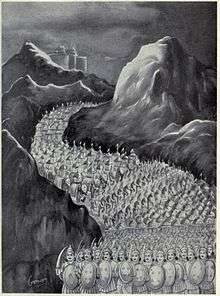Akshauhini
An akshauhini (Sanskrit: अक्षौहिणी), is described in the Mahabharata as a battle formation consisting of 21,870 chariots (Sanskrit ratha); 21,870 elephants; 65,610 cavalry and 109,350 infantry as per the Mahabharata (Adi Parva 2.15-23).[1][2] The ratio is 1 chariot : 1 elephant : 3 cavalry : 5 infantry soldiers. In each of these large number groups (65,610, etc.), the digits add up to 18.
It is said that the size of Pandavas‘ army in the Kurukshetra war was 7 akshauhinis, and those of Kauravas 11 akshauhinis.
The count is arrived as follows:
One elephant (Gaja), one chariot (Ratha), three horses (Ashwa) and five foot soldiers (Padhata) form a Patti;
Three Pattis form a Sena-Mukha;
Three Sena-Mukhas make a Gulma;
Three Gulmas a Gana;
Three Ganas a Vahini;
Three Vahinis a Pruthana;
Three Pruthanas a Chamu;
Three Chamus a Anikini;
Ten Anikinis form an Akshauhini. Thus an Akshauhini, by calculation, contains 21,870 elephants, 21,870 chariots, 65,610 Horses, and 109,350 foot soldiers.
Kuru Army of 11 Akshauhinis is formed by the kingdom of Hastinapura in alliance with races like the Samsaptakas, Trigartas, the Narayana army, the Sindhu army and Shalya of Madra.
Commanders in Chief: Bhishma (10 days), Drona (5 days), Karna (2 days), Shalya (1 day), Ashwatthama (after Duryodhana loses the mace match with Bhima)
Kaurava Army and Duryodhana's side:
- Bhagadatta the veteran - 1 Akshauhini
- Shalya, king of Madra - 1 Akshauhini
- Nila of Mahishmati - 1 Akshauhini (from south)
- Kritavarma (Krishna's Narayani sena of Yadavas) - 1 Akshauhini
- Jayadratha (Saindhava) - 1 Akshauhini
- Sudakshina, king of Kambhoja - 1 Akshauhini (has Yavanas & Sakas in his troops)
- Vinda and Anuvinda (from Avanti) - 1 Akshauhini
- Kalinga Forces - 1 Akshauhini
- Shakuni of Gandhara - 1 Akshauhini
- Susharma of Trigata - 1 Akshauhini
- Kurus and other Allies - 1 Akshauhini
Pandava Army: is a coalition of 7 Akshauhinis, primarily the Panchala and Matsya forces, the Rakshasa forces of Bhima's son, and Vrishni-Yadava heroes.

Pandava Army and their Allies:
- Satyaki of the Vrishni clan - 1 Akshauhini
- Kuntibhoja - 1 Akshauhini
- Dhrishtaketu, king of Chedis - 1 Akshauhini
- Sahadeva, son of Jarasandha - 1 Akshauhini (from Magadha)
- Drupada with his sons - 1 Akshauhini
- Virata the king of Matsya - 1 Akshauhini
- Pandya, Chola and other allies - 1 Akshauhini
The 4 types of units that make up an Akshauhini can also be seen in Chaturanga, the predecessor of chess.
